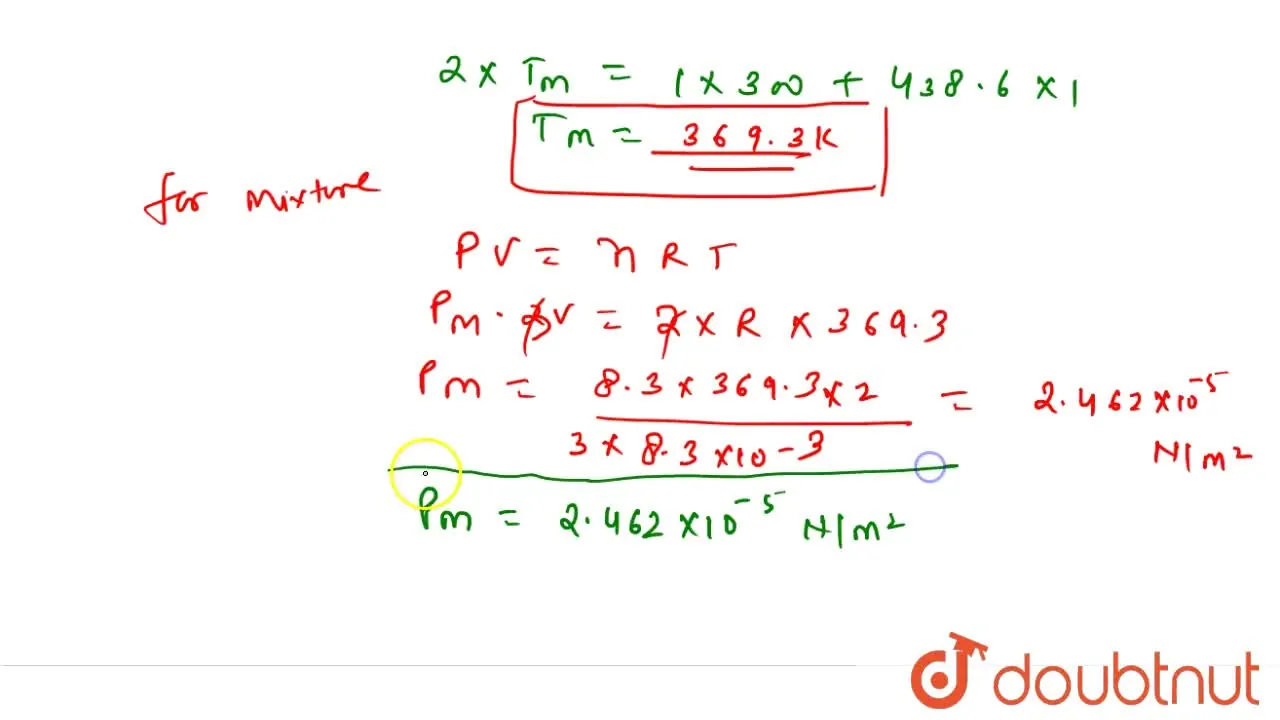There are two vessels. Each of them contains one moles of a monoatomic ideal gas. Initial volume of the gas in each vessel is 8.3×10−3m3at27∘C. Equal amount of heat is supplied to each vessel. In one of the vessels, the volume of the gas is doubled without change in its internal energy, whereas the volume of the gas is held constant in the second vessel. The vessels are now connected to allow free mixing of the gas. Find the final temperature and pressure of the combined gas system.
Accodring to lst law of theromodynamics,
ΔQ=ΔU+W
So for the vessel for which internal energy (and hence, temperature) remains constant.
ΔQ1=W=nRTloge(Vf/V1)
ΔQ1=1×R×300loge(2)=0.693×300R=207.9R
and for the vessel for which volume is kept constant.
ΔQ2=ΔU=nCVΔT [as W=0]
i.e., ΔQ1=1(3/2)RΔT
Accodring to given problem ΔQ1=ΔQ2 i.e.,
207.9R=(3/2)RΔT, i.e., ΔT=138.6
i.e., TF−T1=138.6 with T1=300K
So, TF=300+138.6=438.6K
Now when the free mixing of gases is allowed
U1+U2=U
n1(CV)1T1+n2(CV)2=nCVT
with n=n1+n2
Here n1=n2=1
and (CV)1=(CV)2=CV
So 1×300+1×438.6=2T,
i.e., T=369.3K
Further for the mixture form PV=nRT with V=V+2V=3V and n=n1+n2=2, we have
P=nRT3V=2×8.3×369.33×8.3×10−3=2.462×105N/m2
Related Playlists
- BOOK - RESONANCECHAPTER - KTG & THERMODYNAMICSEXERCISE - Board Level Exercise1videos
KTG & THERMODYNAMICS
- BOOK - RESONANCECHAPTER - KTG & THERMODYNAMICSEXERCISE - SECTION (B)3videos
KTG & THERMODYNAMICS
- BOOK - RESONANCECHAPTER - KTG & THERMODYNAMICSEXERCISE - Solved problem1videos
KTG & THERMODYNAMICS
- BOOK - RESONANCECHAPTER - KINETIC THEORY OF GASES AND THERMODYNAMICSEXERCISE - Exercise64videos
KINETIC THEORY OF GASES AND THERMODYNAMICS
- BOOK - RESONANCECHAPTER - MAGNETIC FIELD AND FORCESEXERCISE - Exercise65videos
MAGNETIC FIELD AND FORCES
Similar Questions
Heating of Gas in Open Vessel
View SolutionOne mole of an ideal gas present in a closed vessel, is compressed to one third of its original volume under constant temperature then % increase in pressure of gas is -
View SolutionA gas is kept at 130C in a vessel, if the volume of the gas is kept constant and is heated, the pressure will be doubled to its initial pressure at a temperature
View SolutionAn open vessel at 27∘C is heated until 3/5th of the air in its has been expelled. Assuming that the volume of the vessel remains constant find
the air escaped out if vessel is heated to 900K.View SolutionTwo vessels of the same volume contain the same gas at same temperature. If the pressure in the vessels is in the ratio of 1 : 2, then
View SolutionA vessel contains N molecules of a gas at temperature T. Now the number of molecules is doubled, keeping the total energy in the vessel constant. The temperature of the gas is
View SolutionA vessel is filled with an ideal gas at a pressure of 20atm and is a temperature of 27∘C One - half of the mass is removed from the vessel and the temperature of the remaining gas is increased to 87∘C. At this temperature, Find the pressure of the gas.
View SolutionOne mole of a monoatomic ideal gas is mixed with one mole of a diatomic ideal gas . The molar specific heat of the mixture at constant volume is
View SolutionA closed vessel 10L in volume contains a diatomic gas under a pressure of 105N/m2. What amount of heat should be imparted to the gas to increase the pressure in the vessel five times?
View SolutionA vessel is filled with an ideal gas at a pressure of 10 atmospheres and temp 270C. Half of the mass of the gas is removed from the vessel the temperature of the remaining gas is increased to 870C. Then the pressure of the gas in the vessel will be
View Solution


